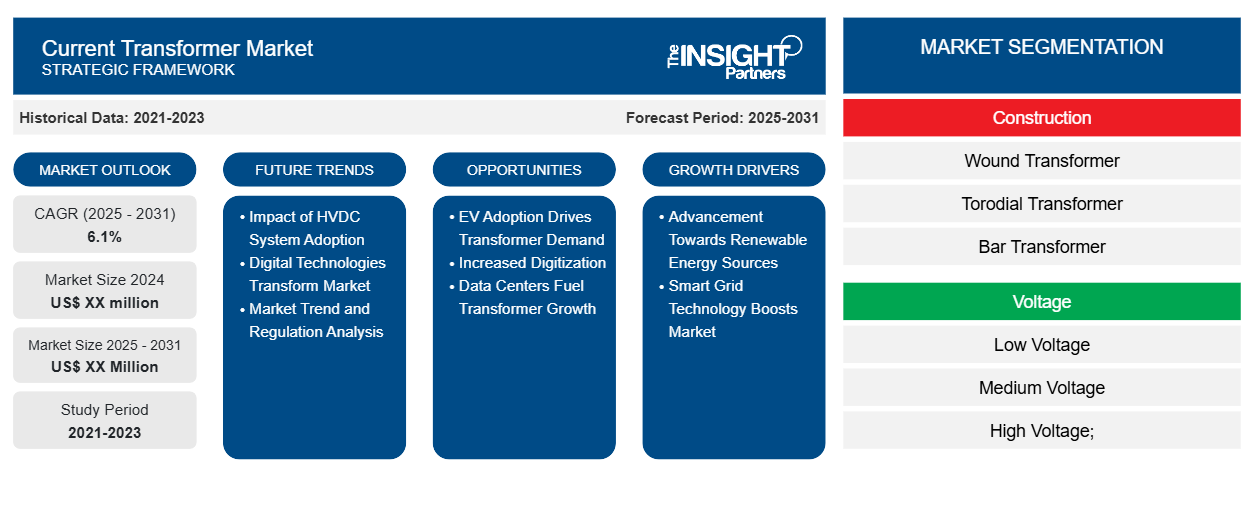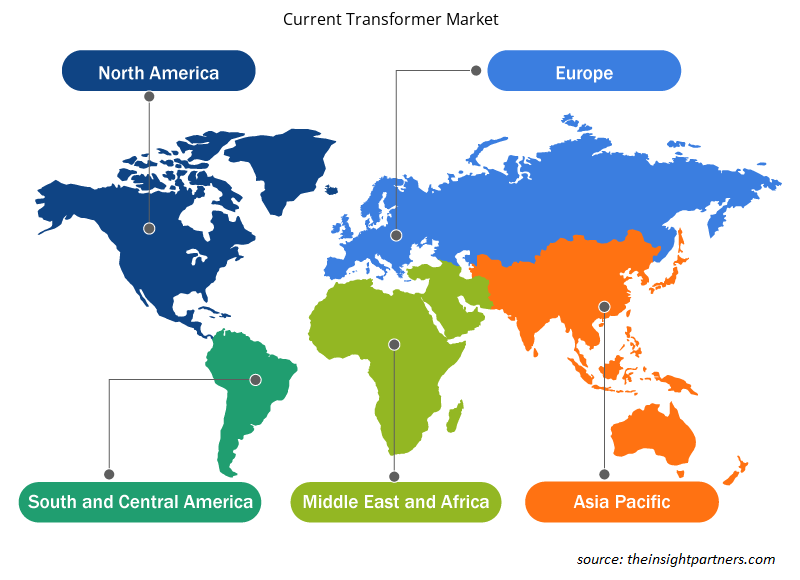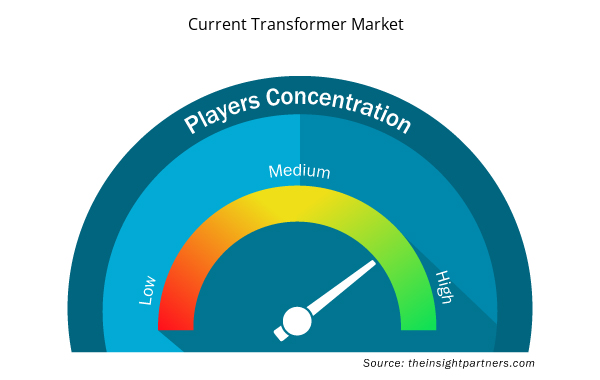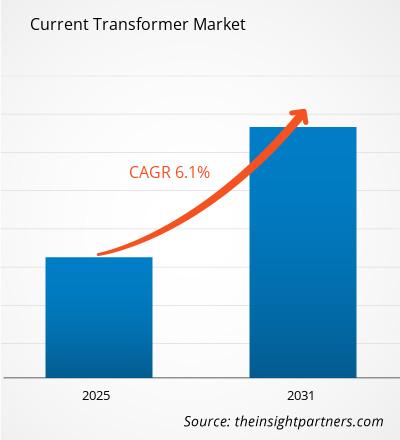Es wird erwartet, dass der Markt für Stromtransformatoren von 2025 bis 2031 eine durchschnittliche jährliche Wachstumsrate (CAGR) von 6,1 % verzeichnet, wobei die Marktgröße von XX Millionen US-Dollar im Jahr 2024 auf XX Millionen US-Dollar im Jahr 2031 anwachsen wird.
Der Bericht zum Stromtransformatormarkt umfasst Analysen nach Konstruktion, Spannung, Verwendung und Anwendung. Geografisch ist der Markt in Nordamerika, Europa, den asiatisch-pazifischen Raum sowie Süd- und Mittelamerika unterteilt.
Zweck des Berichts
Der Bericht „Stromtransformatormarkt“ von The Insight Partners zielt darauf ab, die aktuelle Landschaft und das zukünftige Wachstum sowie die wichtigsten treibenden Faktoren, Herausforderungen und Chancen zu beschreiben. Dies wird verschiedenen Geschäftspartnern Einblicke geben, wie zum Beispiel:
- Technologieanbieter/-hersteller: Um die sich entwickelnde Marktdynamik zu verstehen und die potenziellen Wachstumschancen zu kennen, damit sie fundierte strategische Entscheidungen treffen können.
- Investoren: Durchführung einer umfassenden Trendanalyse hinsichtlich der Marktwachstumsrate, der finanziellen Marktprognosen und der Chancen entlang der Wertschöpfungskette.
- Regulierungsbehörden: Sie regulieren Richtlinien und polizeiliche Maßnahmen auf dem Markt mit dem Ziel, Missbrauch zu minimieren, das Vertrauen der Anleger zu bewahren und die Integrität und Stabilität des Marktes aufrechtzuerhalten.
Stromtransformator Marktsegmentierung
Konstruktion
- Gewickelter Transformator
- Ringkerntransformator
- Stangentransformator
Stromspannung
- Niederspannung
- Mittelspannung
- Hochspannung;
Anwendung
- Energiesektor
- Fertigungssektor
Geographie
- Nordamerika
- Europa
- Asien-Pazifik
- Süd- und Mittelamerika
- Naher Osten und Afrika
Passen Sie diesen Bericht Ihren Anforderungen an
Sie erhalten kostenlos individuelle Anpassungen an jedem Bericht, einschließlich Teilen dieses Berichts oder einer Analyse auf Länderebene, eines Excel-Datenpakets sowie tolle Angebote und Rabatte für Start-ups und Universitäten.
Stromtransformatormarkt: Strategische Einblicke

- Holen Sie sich die wichtigsten Markttrends aus diesem Bericht.Dieses KOSTENLOSE Beispiel umfasst eine Datenanalyse von Markttrends bis hin zu Schätzungen und Prognosen.
Wachstumstreiber auf dem Markt für Stromtransformatoren
- Entwicklung hin zu erneuerbaren Energiequellen: Der Markt für Stromtransformatoren boomt aufgrund eines der wichtigsten Trends: der Entwicklung hin zu erneuerbaren Energiequellen. In diesem Szenario werden überall dort, wo sich Solar- und Windenergieanlagen auf der ganzen Welt ausbreiten, genaue Messungen und Überwachungen der elektrischen Parameter durchgeführt. IRENA hat berichtet, dass die Kapazität für erneuerbare Energien weltweit gewachsen ist und im Jahr 2021 bei 2.799 GW lag. Im Jahr 2020 lag diese Zahl bereits bei 2.531 GW. Dieses Wachstum erfordert effiziente Stromtransformatoren für stabile Netze, und daher gibt es ein verstärktes Marktwachstum sowie einen verbesserten Marktanteil im Energiesektor.
- Smart Grid-Technologie beflügelt den Markt: Der Markt für Stromwandler wird stark von der Smart Grid-Technologie angetrieben, deren fortlaufende Entwicklung ihn so sehr fördert, dass Stromwandler für Smart Grids äußerst wichtig werden, da solche Messlösungen eine verbesserte Effizienz und Zuverlässigkeit bieten
Aktuelle Transformatormarkt-Zukunftstrends
- Auswirkungen der Einführung von Hochspannungs-Gleichstrom-Übertragungssystemen: Die Einführung von Hochspannungs-Gleichstrom-Übertragungssystemen (HGÜ) hat drastische Auswirkungen auf den Markt für Stromtransformatoren. Schätzungen für 2023 zufolge wird der HGÜ-Markt aufgrund der Nachfrage nach effizienter Stromübertragung über große Entfernungen bis 2026 ein Volumen von 18,8 Milliarden US-Dollar erreichen. Staatliche Anreize für Projekte im Bereich erneuerbarer Energien verstärken diesen Trend, wie die PEST-Analyse zeigt. Die Marktstrategie der wichtigsten Akteure, insbesondere ABB und Siemens, zielt strikt auf die Spezialisierung auf Stromtransformatoren für HGÜ-Anwendungen. Ein immer deutlicherer Trend in der Marktdynamik hin zu effizienteren Technologien im Zusammenhang mit dieser Übertragung ist ein verräterisches Zeichen.
- Digitale Technologien verändern den Markt: Digitale Technologien und das Internet der Dinge (IoT) revolutionieren den Stromtransformatormarkt. Über 50 % der Stromtransformatoren könnten bis 2025 mit digitalen Überwachungs- und IoT-Funktionen ausgestattet sein. SWOT-Analyse. Zu den Stärken zählen eine bessere Datenerfassung und Überwachung, während die Schwächen durch Cybersicherheitsrisiken dargestellt werden.
- Markttrend- und Regulierungsanalyse: Die Kurven werden steiler und strengere Vorschriften zu Energieeffizienz und Leistungsstandards beeinflussen den aktuellen Transformatormarkt. Eine PEST-Analyse beweist, dass diese Vorschriften tatsächlich Innovationen im Transformatordesign fördern. Die wichtigsten Akteure wie General Electric und Eaton überarbeiten ihre Marktstrategien, um auf diese Anforderungen zu reagieren. Dies unterstreicht die allgemeine Marktdynamik, die die Energieeffizienz und Nachhaltigkeit verbessert. Die Umsetzung dieser Standards wird zu einer Senkung der Betriebskosten für Versorgungsunternehmen um bis zu 10 % führen.
Marktchancen für Stromtransformatoren
- Einführung von Elektrofahrzeugen treibt die Nachfrage nach Transformatoren: Die schnelle Einführung von Elektrofahrzeugen erfordert eine leistungsstarke Ladeinfrastruktur, die Stromtransformatoren für eine reibungslose Stromverteilung umfasst. Schätzungen zufolge werden bis zum Jahr 2030 25 Millionen Elektrofahrzeuge auf den Straßen der USA unterwegs sein. Dies wird die Nachfrage nach zuverlässigen Stromtransformatoren sicherlich steigern. Dieser Trend ist eine bedeutende Chance für Hersteller, die sich auf Lösungen für die Infrastruktur von Elektrofahrzeugen spezialisiert haben. Angesichts der sich ändernden Anforderungen im Transportsektor verlangt dieser Markt mehr Innovation in Bezug auf das Produktangebot.
- Zunehmende Digitalisierung: Da die Welt immer digitaler wird, steigt der Bedarf an Rechenzentren ständig an, und in solchen Einrichtungen sind zuverlässige elektrische Systeme unabdingbar. Daher werden auch Stromtransformatoren benötigt, um den Stromverbrauch in diesen Einrichtungen zu überwachen und zu steuern. Der globale Markt für Rechenzentren wird voraussichtlich in Zukunft auf rund 200 Milliarden US-Dollar wachsen, hauptsächlich aufgrund des zunehmenden Bedarfs an Cloud-Computing und Datenspeicherung. In diesem Szenario können sich Anbieter von Stromtransformatoren auf gute Wachstumsaussichten freuen, insbesondere solche, die maßgeschneiderte Lösungen für den spezifischen Strombedarf von Rechenzentren entwickelt haben, was ihren Wettbewerbsvorteil in der Branche stärkt.
- Rechenzentren treiben das Transformatorwachstum voran: Angesichts steigender Energiepreise und Umweltprobleme ist Energieeffizienz in verschiedenen Sektoren zu einer äußerst dringenden Priorität geworden. Die aktuellen Transformatoren sind sehr wichtig für die Überwachung des Energieverbrauchs und die Optimierung der Stromverteilung. Angesichts der Bedeutung, die Energiemanagementlösungen zukommt, sollten sie daher den tatsächlichen physikalischen Gegebenheiten entsprechen. Tatsächlich werden sie dringend empfohlen und als Referenz für die Bereitstellung effizienter Energiemanagementlösungen verwendet. Wie das US-Energieministerium berichtet, erwartet das Energieministerium dagegen, dass sich der Stromverbrauch durch Verbesserungen der Energieeffizienz bis 2030 insgesamt um 10 % senken lässt. Dieser Trend verwehrt den derzeitigen Transformatorherstellern enorme Chancen, sich zu organisieren und die Forschung und Entwicklung intelligenter, energieeffizienter Technologien im Zuge des Wandels der Branche voranzutreiben.
Regionale Einblicke in den Stromtransformatormarkt
Die regionalen Trends und Faktoren, die den Stromtransformatormarkt während des Prognosezeitraums beeinflussen, wurden von den Analysten von Insight Partners ausführlich erläutert. In diesem Abschnitt werden auch die Marktsegmente und die Geografie des Stromtransformatormarkts in Nordamerika, Europa, im asiatisch-pazifischen Raum, im Nahen Osten und Afrika sowie in Süd- und Mittelamerika erörtert.

- Erhalten Sie regionale Daten zum Stromtransformatormarkt
Umfang des Marktberichts über Stromtransformatoren
| Berichtsattribut | Details |
|---|---|
| Marktgröße im Jahr 2024 | XX Millionen US-Dollar |
| Marktgröße bis 2031 | XX Millionen US-Dollar |
| Globale CAGR (2025 - 2031) | 6,1 % |
| Historische Daten | 2021-2023 |
| Prognosezeitraum | 2025–2031 |
| Abgedeckte Segmente | Nach Konstruktion
|
| Abgedeckte Regionen und Länder | Nordamerika
|
| Marktführer und wichtige Unternehmensprofile |
|
Aktuelle Marktteilnehmerdichte für Transformatoren: Deren Auswirkungen auf die Geschäftsdynamik verstehen
Der Markt für Stromtransformatoren wächst rasant, angetrieben durch die steigende Nachfrage der Endnutzer aufgrund von Faktoren wie sich entwickelnden Verbraucherpräferenzen, technologischen Fortschritten und einem größeren Bewusstsein für die Vorteile des Produkts. Mit steigender Nachfrage erweitern Unternehmen ihr Angebot, entwickeln Innovationen, um die Bedürfnisse der Verbraucher zu erfüllen, und nutzen neue Trends, was das Marktwachstum weiter ankurbelt.
Die Marktteilnehmerdichte bezieht sich auf die Verteilung von Firmen oder Unternehmen, die in einem bestimmten Markt oder einer bestimmten Branche tätig sind. Sie gibt an, wie viele Wettbewerber (Marktteilnehmer) in einem bestimmten Marktraum im Verhältnis zu seiner Größe oder seinem gesamten Marktwert vorhanden sind.
Die wichtigsten auf dem Markt für Stromtransformatoren tätigen Unternehmen sind:
- Schneider Electric
- GE Grid Electric
- VAC
- SIEMENS AG
- ABB
Haftungsausschluss : Die oben aufgeführten Unternehmen sind nicht in einer bestimmten Reihenfolge aufgeführt.

- Überblick über die wichtigsten Akteure auf dem Markt für Stromtransformatoren
Wichtige Verkaufsargumente
- Umfassende Abdeckung: Der Bericht deckt die Analyse von Produkten, Dienstleistungen, Typen und Endbenutzern des Stromtransformatormarktes umfassend ab und bietet einen ganzheitlichen Überblick.
- Expertenanalyse: Der Bericht basiert auf dem umfassenden Verständnis von Branchenexperten und Analysten.
- Aktuelle Informationen: Der Bericht stellt durch die Abdeckung aktueller Informationen und Datentrends Geschäftsrelevanz sicher.
- Anpassungsoptionen: Dieser Bericht kann angepasst werden, um spezifische Kundenanforderungen zu erfüllen und die Geschäftsstrategien optimal anzupassen.
Der Forschungsbericht zum Markt für Stromtransformatoren kann daher dabei helfen, die Branchensituation und Wachstumsaussichten zu entschlüsseln und zu verstehen. Obwohl es einige berechtigte Bedenken geben kann, überwiegen die allgemeinen Vorteile dieses Berichts tendenziell die Nachteile.
- Historische Analyse (2 Jahre), Basisjahr, Prognose (7 Jahre) mit CAGR
- PEST- und SWOT-Analyse
- Marktgröße Wert/Volumen – Global, Regional, Land
- Branche und Wettbewerbsumfeld
- Excel-Datensatz



Report Coverage
Revenue forecast, Company Analysis, Industry landscape, Growth factors, and Trends

Segment Covered
This text is related
to segments covered.

Regional Scope
North America, Europe, Asia Pacific, Middle East & Africa, South & Central America

Country Scope
This text is related
to country scope.
Häufig gestellte Fragen
Some of the customization options available based on request are additional 3-5 company profiles and country-specific analysis of 3-5 countries of your choice. Customizations are to be requested/discussed before making final order confirmation, as our team would review the same and check the feasibility.
The report can be delivered in PDF/PPT format; we can also share excel dataset based on the request.
Key companies in this market are: Schneider Electric, GE Grid Electric, VAC, SIEMENS AG, ABB, Jiangsu Huapeng Transformer, Continental Control System, Trench Limited, Nissin Limited
The Current Transformer Market is expected to register a CAGR of 6.1% from 2023-2031.
Key future trends in this market are - Demand for electrical grid reliability, Integration with smart metering systems, Advancements in transformer efficiency
The major factors impacting the Current Transformer Market are: Increasing Demand for Renewable Energy, Expansion of Smart Grid Infrastructure, and Growing Industrial Automation
Trends and growth analysis reports related to Electronics and Semiconductor : READ MORE..
1.Schneider Electric
2.GE Grid Electric
3.VAC
4.SIEMENS AG
5.ABB
6.Jiangsu Huapeng Transformer
7.Continental Control System
8.Trench Limited
9.Nissin Limited
10.Huayi Electric
The Insight Partners performs research in 4 major stages: Data Collection & Secondary Research, Primary Research, Data Analysis and Data Triangulation & Final Review.
- Data Collection and Secondary Research:
As a market research and consulting firm operating from a decade, we have published and advised several client across the globe. First step for any study will start with an assessment of currently available data and insights from existing reports. Further, historical and current market information is collected from Investor Presentations, Annual Reports, SEC Filings, etc., and other information related to company’s performance and market positioning are gathered from Paid Databases (Factiva, Hoovers, and Reuters) and various other publications available in public domain.
Several associations trade associates, technical forums, institutes, societies and organization are accessed to gain technical as well as market related insights through their publications such as research papers, blogs and press releases related to the studies are referred to get cues about the market. Further, white papers, journals, magazines, and other news articles published in last 3 years are scrutinized and analyzed to understand the current market trends.
- Primary Research:
The primarily interview analysis comprise of data obtained from industry participants interview and answers to survey questions gathered by in-house primary team.
For primary research, interviews are conducted with industry experts/CEOs/Marketing Managers/VPs/Subject Matter Experts from both demand and supply side to get a 360-degree view of the market. The primary team conducts several interviews based on the complexity of the markets to understand the various market trends and dynamics which makes research more credible and precise.
A typical research interview fulfils the following functions:
- Provides first-hand information on the market size, market trends, growth trends, competitive landscape, and outlook
- Validates and strengthens in-house secondary research findings
- Develops the analysis team’s expertise and market understanding
Primary research involves email interactions and telephone interviews for each market, category, segment, and sub-segment across geographies. The participants who typically take part in such a process include, but are not limited to:
- Industry participants: VPs, business development managers, market intelligence managers and national sales managers
- Outside experts: Valuation experts, research analysts and key opinion leaders specializing in the electronics and semiconductor industry.
Below is the breakup of our primary respondents by company, designation, and region:

Once we receive the confirmation from primary research sources or primary respondents, we finalize the base year market estimation and forecast the data as per the macroeconomic and microeconomic factors assessed during data collection.
- Data Analysis:
Once data is validated through both secondary as well as primary respondents, we finalize the market estimations by hypothesis formulation and factor analysis at regional and country level.
- Macro-Economic Factor Analysis:
We analyse macroeconomic indicators such the gross domestic product (GDP), increase in the demand for goods and services across industries, technological advancement, regional economic growth, governmental policies, the influence of COVID-19, PEST analysis, and other aspects. This analysis aids in setting benchmarks for various nations/regions and approximating market splits. Additionally, the general trend of the aforementioned components aid in determining the market's development possibilities.
- Country Level Data:
Various factors that are especially aligned to the country are taken into account to determine the market size for a certain area and country, including the presence of vendors, such as headquarters and offices, the country's GDP, demand patterns, and industry growth. To comprehend the market dynamics for the nation, a number of growth variables, inhibitors, application areas, and current market trends are researched. The aforementioned elements aid in determining the country's overall market's growth potential.
- Company Profile:
The “Table of Contents” is formulated by listing and analyzing more than 25 - 30 companies operating in the market ecosystem across geographies. However, we profile only 10 companies as a standard practice in our syndicate reports. These 10 companies comprise leading, emerging, and regional players. Nonetheless, our analysis is not restricted to the 10 listed companies, we also analyze other companies present in the market to develop a holistic view and understand the prevailing trends. The “Company Profiles” section in the report covers key facts, business description, products & services, financial information, SWOT analysis, and key developments. The financial information presented is extracted from the annual reports and official documents of the publicly listed companies. Upon collecting the information for the sections of respective companies, we verify them via various primary sources and then compile the data in respective company profiles. The company level information helps us in deriving the base number as well as in forecasting the market size.
- Developing Base Number:
Aggregation of sales statistics (2020-2022) and macro-economic factor, and other secondary and primary research insights are utilized to arrive at base number and related market shares for 2022. The data gaps are identified in this step and relevant market data is analyzed, collected from paid primary interviews or databases. On finalizing the base year market size, forecasts are developed on the basis of macro-economic, industry and market growth factors and company level analysis.
- Data Triangulation and Final Review:
The market findings and base year market size calculations are validated from supply as well as demand side. Demand side validations are based on macro-economic factor analysis and benchmarks for respective regions and countries. In case of supply side validations, revenues of major companies are estimated (in case not available) based on industry benchmark, approximate number of employees, product portfolio, and primary interviews revenues are gathered. Further revenue from target product/service segment is assessed to avoid overshooting of market statistics. In case of heavy deviations between supply and demand side values, all thes steps are repeated to achieve synchronization.
We follow an iterative model, wherein we share our research findings with Subject Matter Experts (SME’s) and Key Opinion Leaders (KOLs) until consensus view of the market is not formulated – this model negates any drastic deviation in the opinions of experts. Only validated and universally acceptable research findings are quoted in our reports.
We have important check points that we use to validate our research findings – which we call – data triangulation, where we validate the information, we generate from secondary sources with primary interviews and then we re-validate with our internal data bases and Subject matter experts. This comprehensive model enables us to deliver high quality, reliable data in shortest possible time.

 Holen Sie sich ein kostenloses Muster für diesen Bericht
Holen Sie sich ein kostenloses Muster für diesen Bericht